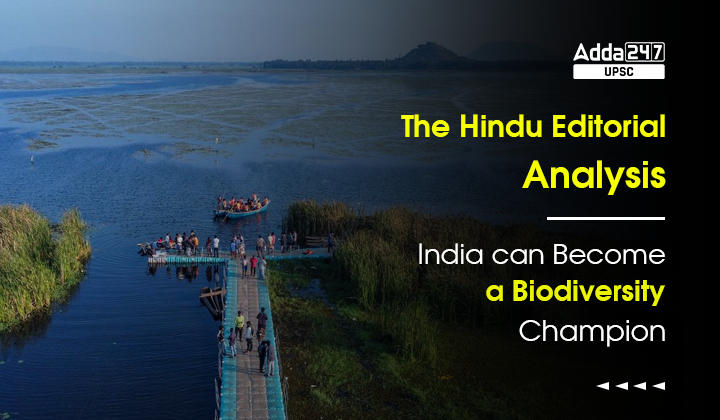Table of Contents
The Hindu Editorial Analysis: The editorial analysis of The Hindu Newspaper Editorial Articles aimed at simplifying various concepts relevant to the UPSC and other State PSC Exams. The Editorial Analysis helps in expanding the knowledge base as well as framing better quality mains answers. Today’s Hindu Editorial Analysis looks into the off-budget borrowings of the states in India.
What is Biodiversity?
The sum and variation of our biological wealth, known as biodiversity, is essential to the future of this planet. The importance of our planet’s biodiversity was strongly articulated at the United Nations Biodiversity Conference in Montreal, Canada.
Global Agreement for Preserving the Biodiversity
On December 19, 2022, 188 country representatives adopted an agreement to “halt and reverse” biodiversity loss by conserving 30% of the world’s land and 30% of the world’s oceans by 2030, known as the 30×30 pledge. India currently hosts 17% of the planet’s human population and 17% of the global area in biodiversity hotspots, placing it at the helm to guide the planet in becoming biodiversity champions.
Union Budget 2023 on Green Growth
The Union Budget 2023 mentioned “Green Growth” as one of the seven priorities or Saptarishis. The emphasis on green growth is welcome news for India’s biological wealth as the country is facing serious losses of natural assets such as soils, land, water, and biodiversity.
Government Schemes promoting Green Growth
National Mission for a Green India
The National Mission for a Green India aims to increase forest cover on degraded lands and protect existing forested lands.
Green Credit Programme
The Green Credit Programme has the objective to “incentivize environmentally sustainable and responsive actions by companies, individuals and local bodies”.
Mangrove Initiative
The Mangrove Initiative for Shoreline Habitats & Tangible Incomes (MISHTI) is particularly significant because of the extraordinary importance of mangroves and coastal ecosystems in mitigating climate change.
PM-PRANAM Initiative
The Prime Minister Programme for Restoration, Awareness, Nourishment, and Amelioration of Mother Earth (PM-PRANAM) for reducing inputs of synthetic fertilizers and pesticides is critical for sustaining our agriculture.
Amrit Dharohar scheme
The Amrit Dharohar scheme directly mentions our biological wealth and is expected to “encourage optimal use of wetlands, and enhance biodiversity, carbon stock, eco-tourism opportunities and income generation for local communities”.
- If implemented in letter and spirit, Amrit Dharohar, with its emphasis on sustainability by balancing competing demands, will benefit aquatic biodiversity and ecosystem services.
- The recent intervention by the Ministry of Environment, Forest and Climate Change to stop the draining of Haiderpur, a Ramsar wetland in Uttar Pradesh, to safeguard migratory waterfowl is encouraging.
Way Forward
Science-based formulation and Implementation
It is critical that these programmes respond to the current state of the country’s biodiversity with evidence-based implementation.
- A science-based and inclusive monitoring programme is critical not only for the success of these efforts but also for documentation and distillation of lessons learnt for replication, nationally as well as globally.
- New missions and programmes should effectively use modern concepts of sustainability and valuation of ecosystems that consider ecological, cultural, and sociological aspects of our biological wealth.
- As far as the Green India Mission is concerned, implementation should focus on ecological restoration rather than tree plantation and choose sites where it can contribute to ecological connectivity in landscapes fragmented by linear infrastructure.
- Furthermore, choice of species and density should be informed by available knowledge and evidence on resilience under emerging climate change and synergies and trade-offs with respect to hydrologic services.
- Site selection should also be carefully considered for the mangrove initiative with a greater emphasis on diversity of mangrove species with retention of the integrity of coastal mud-flats and salt pans themselves, as they too are important for biodiversity.
Local Community Participation
Each of these efforts must be inclusive of local and nomadic communities where these initiatives will be implemented. Traditional knowledge and practices of these communities should be integrated into the implementation plans.
- Each of these programmes has the potential to greatly improve the state of our nation’s biodiversity if their implementation is based on the latest scientific and ecological knowledge.
- As a consequence, each programme should include significant educational and research funding to critically appraise and bring awareness to India’s biological wealth.
National Mission on Biodiversity and Human Wellbeing
The National Mission on Biodiversity and Human Wellbeing has already been approved by the Prime Minister’s Science, Technology, and Innovation Advisory Council (PM-STIAC). This should be immediately launched by the government. This mission seeks to-
- Harness the power of interdisciplinary knowledge — for greening India and its economy,
- Restore and enrich our natural capital for the well-being of our people, and
- Position India as a global leader in applied biodiversity science.
The Editorial Analysis: Going Green



 TSPSC Group 1 Question Paper 2024, Downl...
TSPSC Group 1 Question Paper 2024, Downl...
 TSPSC Group 1 Answer key 2024 Out, Downl...
TSPSC Group 1 Answer key 2024 Out, Downl...
 UPSC Prelims 2024 Question Paper, Downlo...
UPSC Prelims 2024 Question Paper, Downlo...




